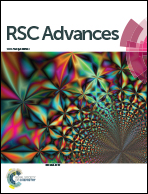Green fabrication of nanoporous BiVO4 films on ITO substrates for photoelectrochemical water-oxidation†
Abstract
A new green method was developed to prepare nanoporous BiVO4 films on ITO substrates for photoelectrochemical (PEC) water-oxidation under visible light irradiation. The films can be prepared by simple drop-casting of a stable aqueous solution of Bi3+ and V5+ complexes with tartaric acid and ethylenediaminetetraacetic acid, followed by drying and calcination in air. Thanks to these ligands, the aqueous precursor solution is remarkably stable over a wide range of pH (pH 4–9). The BiVO4 films on ITO substrates possess a 3D-network structure comprised of nanoparticles with a scheelite–monoclinic phase and a diameter of ca. <100 nm, after calcination at 450–500 °C for 1 h. The PEC performance clearly depended on the film thickness that can be controlled by coating times, and calcination conditions (temperature and time). The CoPi-loaded BiVO4 electrodes exhibited relatively high performance for PEC water oxidation (ABPE of 0.35% at 0.8 V vs. RHE) under simulated sunlight irradiation.



 Please wait while we load your content...
Please wait while we load your content...